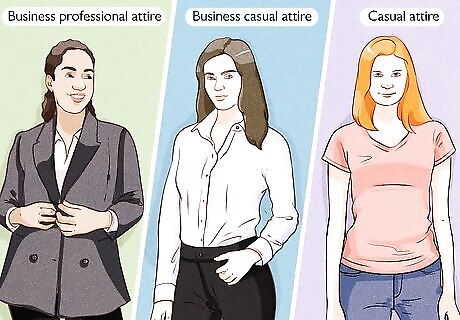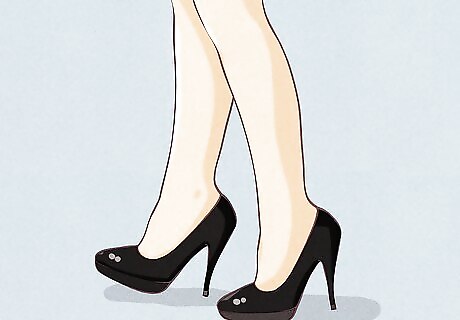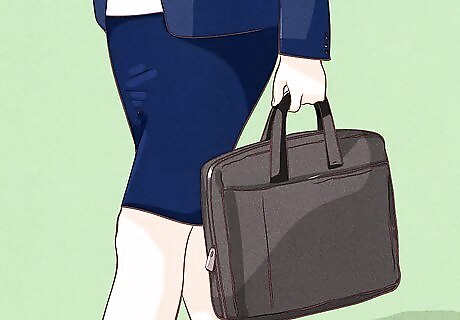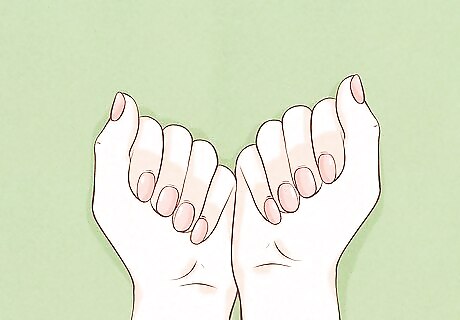
views
Choosing the Right Clothes

Assess the level of formality for your position and workplace. With more workplaces trending towards business casual, or in some cases outright casual, these days, it can be difficult to select the right attire for your specific office. It's best to assess the formality of the office when you go in for an interview. If, however, you are starting your job without visiting the office, there's no shame in asking your boss directly what the office dress code is like. Workplace attire generally falls into one of three categories: Business professional attire is the most formal of business dress codes. This is common in conservative industries like law, finance, accounting, and some government positions. Women in these jobs must be more or less uniform with the men that they work with. This means that you will generally be wearing either a tailored suit or a dress and accompanying structured jacket. Business casual is probably the most common type of business attire in the modern day. Casual, however, is a bit of a misnomer here. You'll typically want to be wearing either a collared shirt or sweater with dress pants or chinos. It's also appropriate to wear a professional-looking dress or skirt and blouse, but make sure that the piece is knee-length or longer. Truly casual attire is rare in any workplace; even "casual Friday" or "no dress code" generally means that you should strive for the lower end of business casual. If, however, you work for a software company or some other progressive company, you may be able to wear casual clothing to work. This means jeans and a t-shirt or, frankly, whatever you want.

Shop for the right clothes. There a few other qualifications you'll want to consider when buying your professional clothes. First, you'll mainly want to focus on buying neutral colors. Think black, grays, subdued blues, and browns. This is especially true for business professional workplaces; business casual workplaces allow for a bit more color. In addition, make sure that: Your dresses and clothes are not too tight or revealing. For business professional workplaces, be sure that your dresses or shirts cover your arms and do not have revealing necklines. In all workplaces, be sure that your clothing is not see-through or too tight. Your clothes are of high quality, or at least not of obviously low quality. Think of your clothing as an investment in your career; you should want to present your best self in the workplace. You'll want to budget about $300-$500 for medium-range clothing or about $2000 for higher end clothing. Your clothes fit and are neatly ironed. This may require some tailoring and dry cleaning. You've bought enough outfits to not repeat one in a week. This is important as people will notice if you frequently wear the same thing.

Create the right outfits. In most cases, you'll want to wear an outfit composed of matching neutrals. It's easier in business professional attire, because suits will obviously always match. However, it's also important in business casual to not dress too loudly. Try matching subtle patterns with other solid-colored items. It's ok to have some louder statement pieces in a business casual environment, just be sure to match them with more conservative pieces. Every businesswoman needs a crisp white shirt, like a white button-down. You should also have a black blazer, a black or grey pencil skirt, and some black or grey slacks. A sophisticated, work-appropriate black dress also works great.

Choose the right shoes. Choosing which shoes you'll wear has a lot to do with your workplace's attire rules and the outfit you'll be wearing them with. In general, business environments will require a woman to wear classic-style pumps or other classic styles with closed toes and heels lower than three inches. Flats are also acceptable. Try to coordinate the color of your shoes to that of your outfit. Avoid shoes that hinder walking quickly. Women should also wear hosiery when wearing a skirt. This should be the same shade or lighter than your outfit. Wear skin-toned hosiery when wearing short-sleeves.
Finishing Your Look

Carry the right accessories. Accessories should also not stand out in the same ways that they do outside of work. In general, women should choose either a purse or a briefcase instead of carrying both. A purse, if carried, should be small and coordinate with the color of your outfit.

Wear little jewelry. Many women tend to wear multiple pieces of jewelry. While this is fine outside of the workplace, business attire standards require that women limit the jewelry that they wear. For example, it is advisable to limit rings to one per hand and wear only a dress watch or simple bracelet rather than multiple bracelets. It is also advisable to keep necklaces simple and avoid dangling earrings. Pearls are always a safe, conservative choice for both necklaces and earrings.

Keep makeup simple. Makeup in the workplace should not make you stand out and should reflect restraint and class. In general, you should apply natural-looking makeup and use only clear nail polish. Use subtle makeup colors to accentuate your eyes and lips. This will bring attention to them and help you to communicate with others.

Keep your hair conservative. Like makeup, hair in the workplace should not distract from work or communication. Hair should be kept shorter than shoulder length and must be a natural color (it can be dyed, just stay away from any unnatural shades). Women with longer hair may wear their hair in a neat braid or a bun.

Keep your fingernails in check. Your fingernails should be manicured and clean. They must be trimmed just above the fingertips or shorter. You should also avoid artificial nails. Again, stick to mainly clear nail polish or nail polishes of very subdued color.




















Comments
0 comment